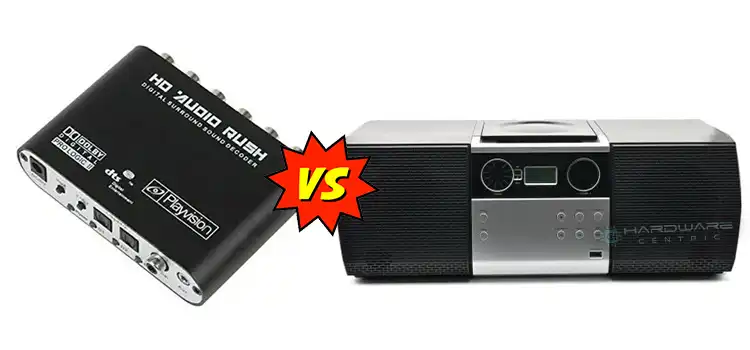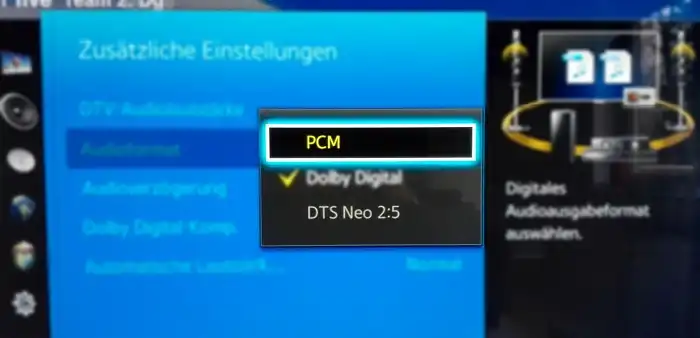DTS Neo 2.5 vs PCM | Deciphering the Sound Technologies
In the evolving landscape of audio technologies, consumers often find themselves at a crossroads when choosing between DTS Neo 2.5 and PCM. These terms, while frequently encountered in sound systems, home theaters, and professional audio setups, can be quite perplexing.
So, which among these offers a superior auditory experience? DTS Neo 2.5 enhances stereo to simulate surround sound, while PCM delivers pure, unprocessed audio. For pure sound, choose PCM; for an immersive experience, opt for DTS Neo 2.5.
Let’s explore the differences between these two sound technologies and identify the suitable one for you.

About DTS Neo 2.5 and PCM
Before we start comparing DTS Neo 2.5 and PCM, let’s learn a bit more detail about them.

DTS Neo 2.5
DTS Neo 2.5 is a proprietary audio technology designed to upscale stereo content to multi-channel sound. It’s often used in home theater systems to enhance the spatial distribution of sound, creating a more immersive experience.
PCM
Pulse Code Modulation (PCM) is a digital representation of an analog signal. Used widely in digital audio formats like CDs, it captures audio data in its purest form, ensuring accurate sound reproduction.
Key Differences between DTS Neo 2.5 and PCM
Look at the table below first:
| Feature | DTS Neo 2.5 | PCM |
| Nature | Post-processing technology | Raw representation of analog signals |
| Usage | Home theaters, video games | Professional audio, CDs |
| Sound Quality | Enhanced surround sound; may alter original audio | Pristine and true to the original recording |
| Compatibility | Requires specific decoding capability | Universal support across devices |
| File Size | Typically smaller due to compression | Larger due to retention of all audio data |
| Flexibility | Designed for a specific auditory output (surround sound) | High flexibility for processing and modification |
Didn’t get the clear idea? Okay, let’s elaborate on it:
- Characteristics:
- DTS Neo 2.5 is designed to upscale stereo content to deliver an enhanced surround sound experience. This means that it transforms pre-existing soundtracks to make them more immersive.
- PCM, on the other hand, provides a digital representation of the original analog signals without any enhancement or alterations. It’s a “what you see is what you get” kind of format.
- Application:
- Devices that aim to provide an immersive audio experience, like home theater systems or gaming consoles, might employ DTS Neo 2.5.
- PCM is a mainstay in professional audio settings and is the standard audio format for CDs.
- Audio Quality:
- DTS Neo 2.5 offers an ambient experience. However, the upscaling can sometimes result in a sound that’s slightly different from the original track.
- With PCM, listeners receive high-fidelity sound that remains faithful to the original recording.
- Suitability:
- DTS Neo 2.5 demands devices that have the necessary decoding capability. Not every device can inherently support it.
- PCM is a universally accepted standard and has wide-ranging support across a plethora of devices.
- Required Space:
- Due to the compression involved, DTS Neo 2.5 files are generally smaller. This might be beneficial for storage but could mean a compromise on some audio details.
- PCM files, in retaining all audio data, are typically larger.
- Adaptability:
- DTS Neo 2.5 is tailored to provide a specific kind of audio output. While it’s great for surround sound, there’s limited wiggle room for modification.
- PCM allows significant flexibility. Since it captures audio in its raw form, it offers extensive room for post-processing and customization.
Advantages and Disadvantages of Both Systems
Pros of DTS Neo 2.5
- Enhances stereo sounds, giving a fuller experience.
- Ideal for movie-watching where ambient sound plays a pivotal role.
Cons of DTS Neo 2.5
- May not be true to the original recording.
- Hardware dependency.
Benefits of PCM
- True representation of the original audio.
- Wide compatibility across devices.
Drawbacks of PCM
- May seem flat in scenarios where ambient sound enhancement is desired.
Our Verdict
Choosing between DTS Neo 2.5 and PCM largely hinges on your specific audio requirements, the equipment you possess, and the kind of listening experience you’re chasing.
If you’re seeking an immersive audio experience, particularly for movies or gaming, DTS Neo 2.5 shines brightly. Its capacity to upscale and enhance sound into a rich, enveloping surround effect can transform your room into a mini-theater or a dynamic gaming arena. The sense of spatial awareness and depth it provides truly enhances the overall auditory experience.
On the other hand, if you’re a purist, an audiophile, or someone who’s involved in professional audio work, PCM is your trusted ally. The raw, unaltered, and high-fidelity nature of PCM ensures that what you hear is as close to the original source as possible. It’s an authentic representation, devoid of any additives or flavorings, giving you sound in its purest form.
But remember, audio, much like taste, is deeply personal. It’s subjective. What sounds euphonic to one might sound cacophonous to another. So, it’s always a good idea to experience both and see which one resonates more with your ears. After all, in the symphony of sound, your personal comfort and preference always play the lead note.
Other Questions You May Ask
Can I convert DTS Neo 2.5 audio to PCM?
Yes, there are software tools available that can convert DTS Neo 2.5 to PCM, but be aware that this might alter the spatial quality of the original recording.
Which is better for music listening, DTS Neo 2.5 or PCM?
If you prefer a more natural, unaltered sound, PCM is the way to go. But for a more immersive experience, DTS Neo 2.5 can be considered.
Do all speakers support both audio formats?
While most modern speakers and systems support PCM, DTS Neo 2.5 requires specific compatibility.
Is PCM suitable for movies?
PCM is excellent for clarity, but if you desire a surround sound feel, DTS Neo 2.5 or other surround codecs might be better.
Is there a significant difference in file sizes between the two?
PCM files are generally larger as they retain more raw audio data, while DTS Neo 2.5 might be more compressed.
Summary
In the battle of DTS Neo 2.5 vs PCM, the right choice ultimately depends on your audio setup and preferences. While DTS Neo 2.5 immerses you in cinematic audio, PCM preserves original quality. Understanding the differences will empower you to make a sound decision that enhances your audio experiences. So, whether you’re streaming movies or enjoying your music collection, choose wisely and savor the soundscape. Have more questions or need guidance? Feel free to drop a comment below. Happy listening!
Subscribe to our newsletter
& plug into
the world of PC Hardwares


![[5 FIXES] Microphone Razer Seiren X Static Noise](https://www.hardwarecentric.com/wp-content/uploads/2023/09/razer-seiren-x-static-noise.webp)
![[9 Fixes] New PC Build No Video Output](https://www.hardwarecentric.com/wp-content/uploads/2023/02/New-PC-Build-No-Video-Output.webp)

![[4 Fixes] Asus VG248QE DisplayPort No Signal](https://www.hardwarecentric.com/wp-content/uploads/2022/12/Asus-VG248QE-DisplayPort-No-Signal.webp)
